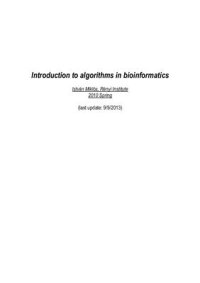
Ebook: Introduction to algorithms in bioinformatics
Author: Miklos I.
- Genre: Biology // Molecular: Bioinformatics
- Tags: Биологические дисциплины, Матметоды и моделирование в биологии, Биоинформатика
- Language: English
- pdf
Renyi Institute, 2013. — 65 p.The notes are divided into 11 chapters covering almost 100 percentage of the material that is taught in this course. The first five chapters are about genome rearrangement. First the history of genome rearrangement is introduced briefly, followed by four chapters discussing the four most important genome rearrangement models and corresponding algorithms. The last six chapters are about dynamic programming algorithms. Many of the optimization problems in bioinformatics can be solved by dynamic programming, and these notes introduce the most important cases.
As the reader can see, this course is pretty much a computer science and combinatorics course with the aim to solve specific problems related to bioinformatics. Only as much biology is covered as necessary to understand why the introduced models and problems are important in biology. However, there will be two students’ presentations during the course. Students have to choose scientific papers from some selected papers, read, understand and present them during the class. There are two aims of the students’ presentation: the first aim is to demonstrate that the acquired knowledge is sufficient to understand moderate scientific papers, the second one is to show how these model work in practice, what kind of biological questions can be answered using the learned tools.
Each chapter ends with a bunch of exercises related to the material covered by the chapter. Some of them are easy exercises with the aim to deepen the knowledge of the students, but there are also exercises that are hard to solve. These exercises are marked with one or two asterisks, the ones with two asterisks considered to be the hardest. There are also software-writing exercises, which are especially for informatics students. Although these exercises are not mandatory for mathematics students, my opinion is that one learns a method best when s/he implements it in a program language. The solutions of the exercises are deliberately not presented in these notes. Some of the exercises will be homework, and the scoring of homework will be part of the evaluation of the students.
As the reader can see, this course is pretty much a computer science and combinatorics course with the aim to solve specific problems related to bioinformatics. Only as much biology is covered as necessary to understand why the introduced models and problems are important in biology. However, there will be two students’ presentations during the course. Students have to choose scientific papers from some selected papers, read, understand and present them during the class. There are two aims of the students’ presentation: the first aim is to demonstrate that the acquired knowledge is sufficient to understand moderate scientific papers, the second one is to show how these model work in practice, what kind of biological questions can be answered using the learned tools.
Each chapter ends with a bunch of exercises related to the material covered by the chapter. Some of them are easy exercises with the aim to deepen the knowledge of the students, but there are also exercises that are hard to solve. These exercises are marked with one or two asterisks, the ones with two asterisks considered to be the hardest. There are also software-writing exercises, which are especially for informatics students. Although these exercises are not mandatory for mathematics students, my opinion is that one learns a method best when s/he implements it in a program language. The solutions of the exercises are deliberately not presented in these notes. Some of the exercises will be homework, and the scoring of homework will be part of the evaluation of the students.
Download the book Introduction to algorithms in bioinformatics for free or read online
Continue reading on any device:

Last viewed books
Related books
{related-news}
Comments (0)